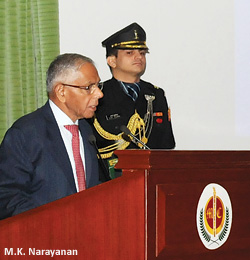INDIAN ARMED FORCES CHIEFS ON OUR RELENTLESS AND FOCUSED PUBLISHING EFFORTS

The insightful articles, inspiring narrations and analytical perspectives presented by the Editorial Team, establish an alluring connect with the reader. My compliments and best wishes to SP Guide Publications.

"Over the past 60 years, the growth of SP Guide Publications has mirrored the rising stature of Indian Navy. Its well-researched and informative magazines on Defence and Aerospace sector have served to shape an educated opinion of our military personnel, policy makers and the public alike. I wish SP's Publication team continued success, fair winds and following seas in all future endeavour!"

Since, its inception in 1964, SP Guide Publications has consistently demonstrated commitment to high-quality journalism in the aerospace and defence sectors, earning a well-deserved reputation as Asia's largest media house in this domain. I wish SP Guide Publications continued success in its pursuit of excellence.
- Indian Air Force Aims for Full Indigenous Inventory by 2047 — Air Chief Marshal A.P. Singh
- General Upendra Dwivedi takes over as the Chief of the Army Staff
- Rajnath Singh assumes charge as Defence Minister for the second consecutive term
- Admiral Dinesh K. Tripathi assumes Command of the Indian Navy as 26th Chief of the Naval Staff
- Prime Minister witnesses 'Bharat Shakti' – a Tri-Services Firing and Manoeuvre Exercise in Pokhran, Rajasthan
Wisdom Speak
Questioned about India’s nuclear forces recently, a Chinese official replied, “Why mention nuclear forces, Indians don’t even know how to use their conventional forces”

For once, someone spoke sense about Special Forces. At the raising day function of the National Security Guard (NSG) this October, former National Security Advisor (NSA) and currently Governor West Bengal M.K. Narayanan said, “A Special Force does not draw strength in numbers. Its strength lies in quality” - globally acknowledged Special Forces truth.
By adding that establishing NSG hubs in Mumbai, Hyderabad, Kolkata and Chennai post-26/11 was a major mistake, Narayanan inadvertently acknowledged two other Special Forces truth: Special Forces cannot be mass produced and Special Forces cannot be created after emergencies arise. Interestingly, these decisions were taken post-26/11 attacks by P. Chidambaram (the then Home Minister) when Narayanan was NSA.
The NSG was created under the National Security Guard Act of 1986. The original Draft CCPA Paper proposed a 25,000-strong NSG Force (16 battalions with three Force Headquarters located in various parts of the country) but following detailed deliberations, sensibly only two Special Action Groups (SAGs) and three Special Ranger Groups (SRGs) performing functions of cordon at the cutting edge were approved as per the Revised CCPA Paper. Bomb disposal and dog units were added later.
NSGs initial selection and training was done by Army’s Para Commandos. The approved CCPA Paper categorically stated that Army will provide manpower for SAGs only for first 10 years (up to 1996) beyond which, personnel of police organisations were to man SAGs but this did not happen. In 2002, when the then Army Chief made a move to stop providing manpower to SAGs, the Cabinet Secretary protested that “NSG will come to a grinding halt” and persuaded the Army to continue existing arrangements. A major reason why SRGs have not come up to SAG standard is employment on VIP security despite the Special Protection Group (SPG) raised for this very purpose. In October 2012, 900 personnel of 11 SRG on VIP security were reportedly reverted for training in counter-terrorism but it wasn’t clarified whether these 900 personnel were replaced by equal number of personnel from another SRG.
What should be of serious concern to policy-makers, strategists and security analysts is Narayanan mentioning in the same speech that the “NSG was caught in ‘doctrinal confusion’ on its role and specially when and how to use them”. This is a sorry state 28 years after raising of the NSG. Obviously, Narayanan as NSA could not have his way because of the turf war between him and Chidambaram, amply covered in media.
But the million-dollar question that remains is who is responsible to work out and implement a doctrine and concept of employment for the NSG—NSA, Home Minister, Home Secretary, who? Who for that matter is responsible to define and execute a National Security Strategy, National Doctrine for Response to Asymmetric Warfare, National Doctrine and Concept of Employment of Special Forces, order a Comprehensive Strategic Defence Review, White Paper on Maoists Insurgency including Pakistani-Chinese support, National Policy for Military Diplomacy, so on and so forth; Defence Minister, Defence Secretary, Home Secretary, NSA, who? What, if at all, is the accountability of the Cabinet Secretary, Defence Secretary and the Home Secretary towards defence of India, both external and internal? Who from the bureaucracy is responsible to firm up the drafts of all these doctrines, policies and concepts, obtain government approval and implement them? Isn’t the continuing apathy deliberate to circumvent accountability? What about conspicuous lack of domain knowledge, resultant cocooned mediocrity and fear/inability in accepting/grasping professional military advice?
Isn’t it time these issues are debated in Parliament, responsibilities fixed and parliamentary oversight instituted? Questioned about India’s nuclear forces recently, a Chinese official replied, “Why mention nuclear forces, Indians don’t even know how to use their conventional forces”. Can someone write this in Braille for our blind men?
The views expressed herein are the personal views of the author.





